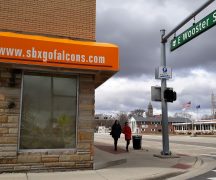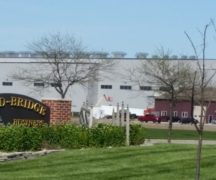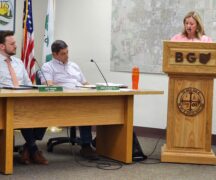By JAN LARSON McLAUGHLIN
BG Independent News
Last year came in like a lamb and went out like a lion for Bowling Green economic development. When it was done, it all added up to more than $47 million being invested in machinery and equipment, and another $24.6 million being spent on construction.
“We’ve had another excellent year,” Bowling Green Economic Development Executive Director Sue Clark told members Wednesday during their annual luncheon meeting.
The first two quarters of 2016 started out slowly, but the last two quarters picked up, Clark said. “We ended the year with a bang.” And the start of 2017 is already proving to be “exceptionally busy,” she said.
Bowling Green now has just under 4,000 manufacturing jobs. Add that to the approximately 3,000 jobs at Bowling Green State University, and “that’s an excellent healthy sign we have a balanced economy,” Clark said.
The city has no empty industrial buildings except for a portion of the former Lear plant. MICC, a British firm that makes high heat resistant cable, is now using part of the facility.
“We’re encouraging people to come look at land, because we can’t show them any buildings,” Clark said.
But even available land in the city’s industrial parks is getting low. There are just a couple acres left in Wood Bridge – though the city is in the process of trying to expand that business park off Dunbridge Road. The John Quinn Innovative Tech Park, off Napoleon Road, has just 7.5 acres left. And Bellard Park on Brim Road has a total of about 28 acres remaining.
The biggest dilemma, however, is the lack of an available workforce.
“The labor pool is stretched about as far as we can get it,” Clark said.
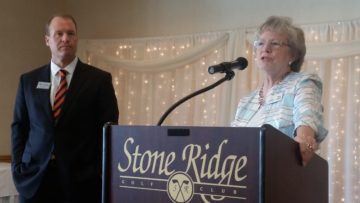
Ben Otley and Sue Clark talk about Bowling Green businesses
Some of the highlights from last year, Clark noted, included the Betco plant getting up to full production, with nearly 170 employees. The company made a $60 million investment in the Bowling Green plant.
“We’re pleased to have them here,” she said.
The city also saw the third addition to Novavision, bringing it to 60 employees, the nearly finished Kroger expansion, and the completion of Fairfield Inn. “We’re very pleased to have another hotel to offer our visitors,” Clark said.
Two new banks came to town – State Bank and Farmers & Merchants – and The Beat dance studio located in Bellard Business Park.
Following is a list of the companies making investments in their Bowling Green businesses during 2016:
- Absorbent Products, $100,000.
- Apio, $300,000.
- Betco, $21 million in equipment and machinery, $23,374,167 in new facility or addition.
- Biofit, $20,000.
- CMC Group (Century & Daymark), $1.5 million.
- Cooper, $5.3 million.
- Copy Shop, $20,000.
- DOWA, $81,047.
- Henschen & Associates, $15,000.
- Hindley Electronics, $10,000.
- Jim Palmer Excavating, $130,000.
- Nichols, $90,000.
- Lubrizol, $1.4 million.
- Regal, $50,000.
- Novavision, $150,000.
- Phoenix Technologies, $2,425,000.
- Pinnacle Plastic Products, $131,000.
- Pioneer Packing, $60,000.
- Poggemeyer Design, $150,000.
- Rosenboom Machine & Tool, $462,000.
- Southeastern Container, $3.6 million.
- TH Plastics, $2.5 million.
- Vehtek, $7 million.
- Williams Industrial Services, $100,000.
- Ironhead, $36,000.
- Xorb, $350,000.
Also at the annual economic development meeting, Clark and Ben Otley, president of the Bowling Green Community Development Foundation, presented the “Friend of Economic Development” award to Mike Marsh.
“He’s wisely guided us through the high times and the rough spots,” Clark said.
Being a native of Bowling Green, Marsh seems to know everyone, she said. “He’s guided us through political minefields.”
Marsh has also served as president of the foundation three times.
Tim Brown, the keynote speaker, called Marsh a “behind the scenes supporter who makes the engines churn.”
But Marsh downplayed his efforts and said he just plays a small role with everyone else. “It’s part of the job when you live in a small town,” he said.
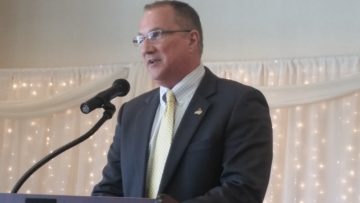
TMACOG Director Tim Brown
Brown, a former Wood County commissioner and state representative, now serves as president of the Toledo Metropolitan Area Council of Governments. The organization, he said, is designed to get regional elected officials to the table and talking. The non-partisan group focuses its regional planning efforts on transportation, water quality, clean air requirements and economic development.
One of the big topics being discussed now is water distribution, since many of the communities being served by Toledo water are objecting to the large surcharge and the demands to share revenue from economic development.
“Folks are looking at alternatives to bypass Toledo,” Brown said.
Many customer communities are interested in a regionally shared and governed water system. Brown said Toledo seems to realize the seriousness of the situation and has agreed to bring in an outside facilitator for negotiations.
Bowling Green recently started supplying water to Waterville, allowing that community to leave the Toledo system. Perrysburg and Maumee are also considering that option.
“The region now has opportunities other than Toledo, and Toledo knows that,” he said.
“We’re Switzerland,” Brown said of TMACOG’s role. However, he added that the region’s businesses and citizens will benefit from a shared system that does away with huge surcharges.


